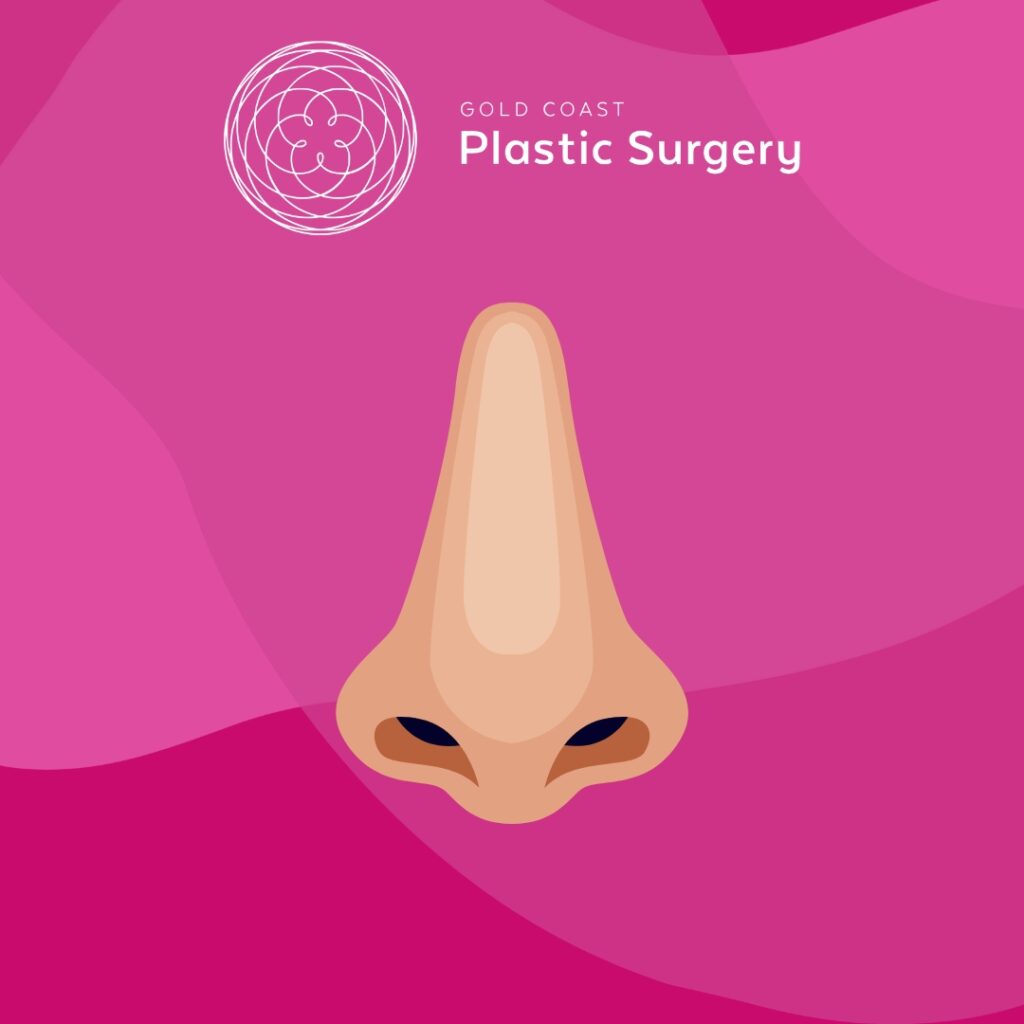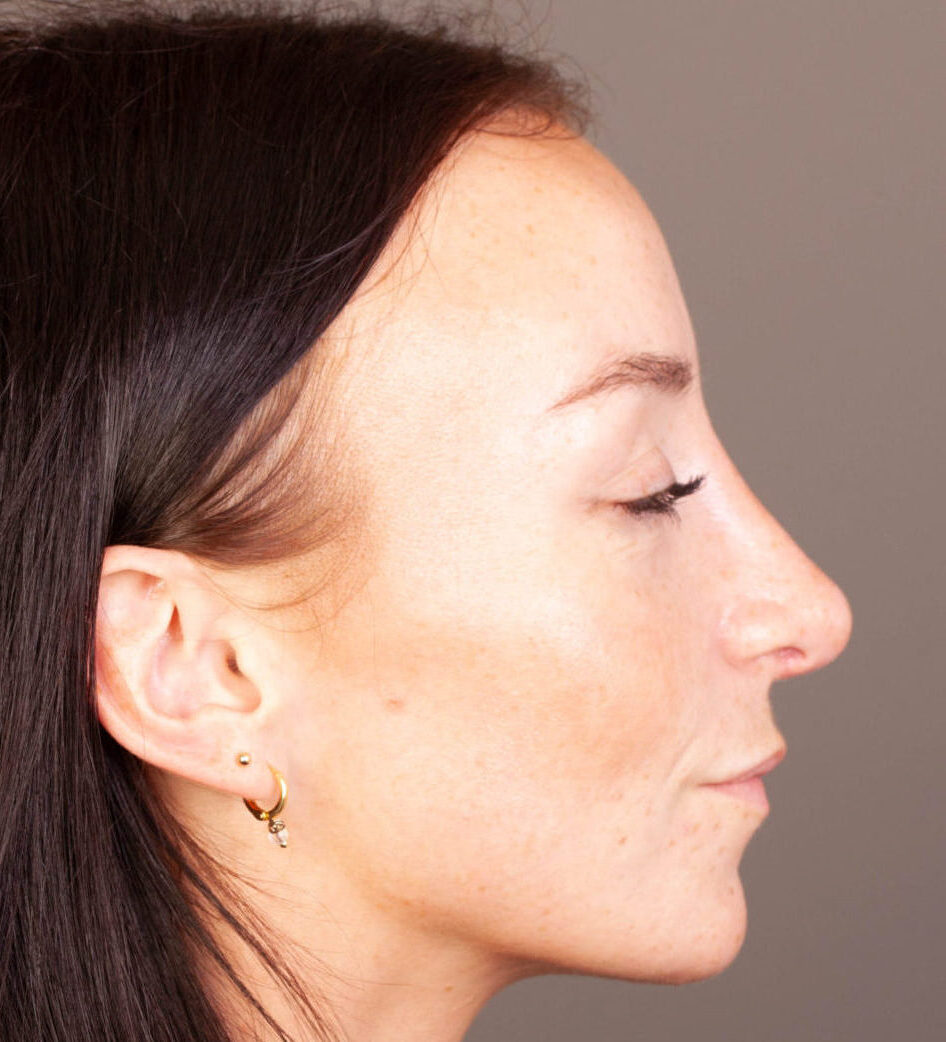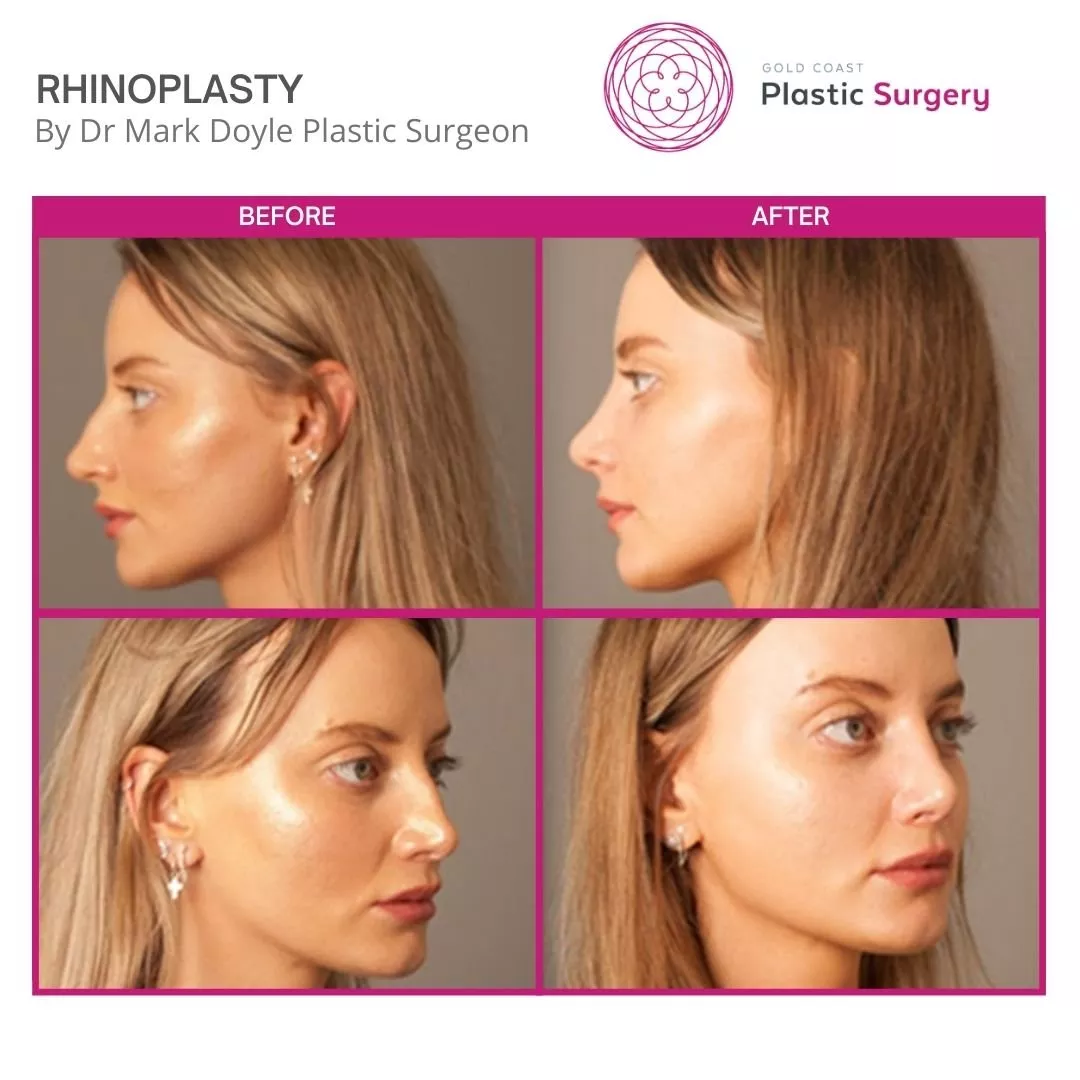Rhinoplasty (Nose Job) Gold Coast

The nose is a prominent facial feature, if you are seeking to change the shape or size of your nose, you may be a suitable candidate for cosmetic surgery of the nose, known as Rhinoplasty.
At Gold Coast Plastic Surgery, we have the privilege of witnessing many of our patients’ rhinoplasty (a cosmetic nose job) surgery journeys. Specialist Plastic Surgeon Dr Doyle boasts 30+ years of experience and has performed hundreds of rhinoplasty surgeries in his career with the techniques, skills and expertise he learned during his 10+ years of FRACS (Plas) studies and training.
Rhinoplasty, at a glance
Target area: Nasal bridge (dorsum), nasal tip, nostrils
Time off work: 1 – 2 weeks
Total recovery: 6 weeks
Splint: Nasal splint required, appox 5 – 7 days
Scar position: On the skin that separates the nostrils
What is Rhinoplasty?
A rhinoplasty, also known as a nose job, can be performed for both cosmetic and medical reasons to shape, reduce or repair the nose. Rhinoplasty surgery can straighten a nose, change the shape of the nose and improve breathing difficulties.
Undergoing a rhinoplasty for cosmetic reasons can involve reducing or straightening the nose. One of the most common reasons for our Gold Coast Plastic Surgery patients undergoing a Rhinoplasty (nose job) is to straighten the bridge of the nose (dorsal hump). This involves operating and reducing the cartilage and bone that give your nose its shape and structure.
Other Nose Surgery Procedures
Gold Coast Specialist Plastic Surgeon Dr Doyle specialises in Tip Rhinoplasty or Tip Plasty procedures which can refine the tip of your nose by reducing the amount of cartilage. Similarly, if your nostrils are your concern, you may be a suitable candidate for Dr Doyle to perform Nostril Reduction surgery or Alarplasty surgery in conjunction with traditional Rhinoplasty surgery.
Am I A Suitable Candidate for Rhinoplasty (Nose Job)?
A Rhinoplasty can straighten a nose, change its shape and improve breathing difficulties. This procedure can attract Medicare and health insurance rebates if certain criteria is met. If the procedure is performed to correct the impact of an injury to treat breathing difficulties, there’s a good chance that some of the costs will be covered. (nose job) can be suitable for both men and women of all ages, as long as the nose is fully developed. This means that surgery is appropriate from the age of 18 for males, and 16 for females.
Rhinoplasty surgery outcomes are most successful when you’re in good general health, with firm nasal cartilage and healthy, elastic skin. While there is no recommended upper age limit on who can undergo a rhinoplasty, the results are generally better when performed earlier in adulthood, when skin health is optimal.
Take our quiz or book a consultation to find out if you’re a suitable candidate for surgery!
What to Expect From a Rhinoplasty (Nose Nob)
Rhinoplasty can straighten a nose, change its shape and improve breathing difficulties. This procedure can attract Medicare and health insurance rebates if certain criteria is met. If the procedure is performed to correct the impact of an injury or to treat breathing difficulties, there’s a good chance that some of the costs will be covered by Medicare.
While Dr Doyle is located on the Gold Coast, his Rhinoplasty (nose job) patients travel to the Gold Coast from Brisbane, Byron Bay, the Sunshine Coast and all over Australia to see him, with minimal travel time as Gold Coast Plastic Surgery is located next to the Gold Coast Airport, and flexible aftercare appointments.
Rhinoplasty Patient Gallery
Disclaimer: All information on the Gold Coast Plastic Surgery website is general in nature and is not intended to be medical advice, nor does it constitute a doctor-patient relationship. Results can vary significantly and depend on individual patient circumstances. Please be aware that the outcomes shown are specific to those patients and may not necessarily reflect the results others may experience. Individual results can vary due to many factors, including genetics, diet, and exercise. All images on this website, unless specified as real patient images, are graphics used for illustrative purposes only. Surgery risks and complications will be covered in detail during a consultation with your surgeon. Book a consult for details regarding your cosmetic surgery procedure

Rhinoplasty

Rhinoplasty

Rhinoplasty

Rhinoplasty

View All Rhinoplasty (Nose Job) Photos
The Rhinoplasty Procedure
During your consultation, Dr Doyle will explain the details of your surgery so you can make an informed decision.
The rhinoplasty procedure is performed under general anaesthesia and normally takes 1 to 2 hours to complete.
Dr Doyle can perform closed or open rhinoplasty depending on your anatomy and surgery requirements.

Closed Rhinoplasty Technique
To perform a closed rhinoplasty procedure, the incisions are made inside the nose. This technique is most commonly used to correct nasal cartilage and the septum.
Open Rhinoplasty Technique
To perform open rhinoplasty, the incision is made across the small area of skin that separates the nostrils. Once the skin is lifted away from the nasal bone, it gives Dr Doyle better access to the underlying structures. Open rhinoplasty is used in more complex rhinoplasty cases.
Once the recommended changes have been made, the skin is re-draped and the incisions are closed. This is a day procedure and you will have a splint on your nose that will need to be removed by our nurses at 5 – 7 days post-surgery. Please note, that you will also need someone to drive you home once you’ve been discharged.
What Types of Incisions can be used?
Two rhinoplasty incision techniques can be used, depending on your circumstances and preferred surgical outcome.
- The first is an open rhinoplasty technique. This involves making small incisions across the tissue between the nostrils (columella). This technique is recommended when correcting a twisted or crooked nose, as well as shaping the tip of the nose.
- The second is a closed rhinoplasty technique. This involves making small incisions within the nostrils, without the use of external incision sites. This technique is recommended when reducing the size of a dorsal hump on the bridge of the nose, as well as when reducing the width of the nostrils.
How long will the Rhinoplasty surgery take?
Rhinoplasty surgery is performed under general anaesthesia and normally takes 1 to 2 hours to complete. It requires a day stay in the hospital.
What will my Rhinoplasty surgery recovery be like?
You will have a splint on your nose that will need to be removed by our nurses at 5-7 days post-operation. During this time, it’s recommended you rest, ice your nose and undergo regular nasal cleaning. Normal activity can be resumed in 2 to 3 weeks. Dr Doyle will provide you with specific aftercare instructions after surgery that should be carefully followed.
What will happen during my rhinoplasty recovery?
After rhinoplasty, patients can expect swelling, bruising and discomfort for a few weeks. Patients can expect to spend 10 – 14 days at home before returning to work. After four to six weeks, once the swelling begins to subside you will begin to see the results.
It can take up to six weeks for the nasal bones to calm and recover. Throughout the next year, your nose will go through gradual changes before your final results will be visible. Swelling from a Rhinoplasty can last up to a year. Patience is required during rhinoplasty recovery and any activities that could harm your nose should be avoided for at least six months.
Since rhinoplasty incisions are very small, scarring is generally not a cause for concern.
Read Dr Doyle’s cosmetic surgery recovery tips to ensure a smooth recovery.
Some precautions you will need to take after surgery include:
- No nose-blowing
- No vigorous activities or exercise
- Take baths instead of showers while wearing bandages
- Don’t wear clothes that pull over your head
- Don’t rest glasses on your nose for at least a month
- Use sunscreen on your nose when you venture outside
Is Rhinoplasty Surgery Suitable For You?
Surgery should never be undertaken lightly. While getting a nose job (Rhinoplasty) for medical reasons is sometimes a more straightforward decision, doing it for cosmetic reasons is something that should be given careful consideration.
Even though revision surgery is possible, this is the sort of procedure you want to be 100% sure is suitable for you prior to undergoing it. You should never have cosmetic surgery to please someone else, this is arguably the worst reason to have surgery.
If you believe that rhinoplasty may improve the functionality of your nose and you’re content with the physical change and recovery, then we recommend you book a consultation with Dr Doyle at Gold Coast Plastic Surgery today.
How Much Does a Rhinoplasty (Nose Job) Cost in Australia? – Prices and Fees for Rhinoplasty
Every nose is unique and every rhinoplasty surgery plan is customised to the individual. During your consultation, your specific surgery goals and concerns will need to be discussed. Once Dr Doyle has decided on a tailored surgical approach, the anaesthetist, surgeon and hospital fees will also be factored into the final cost.
You may be eligible for a Medicare rebate and coverage by your Private Health Fund if your surgery meets the strict criteria.
For more information about Rhinoplasty payment plans or Rhinoplasty pricing visit our Pricing resources:
The cost of a Rhinoplasty in Australia has been outlined in our cosmetic surgery price list.
For more information on medically necessary Rhinoplasty, view our blog, Will Medicare Cover My Rhinoplasty in Queensland?
Rhinoplasty FAQs

Will revision surgery be necessary?
Revision rhinoplasty is only necessary if you’re very unsatisfied with your results or your nose is damaged after surgery. An initial consultation is required to ensure Dr Doyle understands exactly what you want to surgical achieve. He will also use this time to make recommendations based on your face shape and ensure you have realistic expectations about what can be achieved with revision rhinoplasty surgery.
What about non-surgical rhinoplasty?
A non-surgical rhinoplasty may be an option but the possibilities are limited. Please note, that non-surgical rhinoplasty treatments can only correct minor irregularities and won’t make a difference for those with breathing irregularities.
What are the Potential Risks Involved with Rhinoplasty?
During your pre-surgery consultation, your surgeon will thoroughly address the risks associated with rhinoplasty before any decisions are made regarding you going ahead with the surgery.
All of the risks associated with surgery are a possibility with rhinoplasty surgery. Bleeding and infection are two of the most common complications. Asymmetry and loss of sensation are some of the other less common complications, although, they can occur. With the help of Dr Doyle and his experienced team and by following his specific aftercare instructions, complications can be minimised.
General complications of surgery include:
- Pain
- Bleeding
- Infection of the surgical site (wound)
- Blood clots
Specific complications of Rhinoplasty include:
- Adhesions, where scar tissue forms deep inside your nose
- Redness
- Bruising and swelling
- Bleeding caused by infection
- Scarring
- Developing an abscess
- The shape of the nose
- Injury to nerves
- Nasal obstruction
- Reduced sense of smell
While these are uncommon, any surgical procedure comes with risk. You should always seek a second opinion before undergoing surgery.
Planning for a Rhinoplasty (Nose Job)
The decision to undergo Rhinoplasty surgery (nose job) isn’t an easy one to make. The surgery itself requires complexity in surgical technique and a clear vision of the preferred surgery result. There are many points to consider with the level of pre-operative planning, the surgery itself, and the period of recovery that is required.
In the planning stage, you’ll need to develop realistic expectations of your Rhinoplasty (nose job) surgical outcome. Any surgeon is unlikely to perform rhinoplasty surgery on you if you’re seeking drastic changes that won’t suit your face. Instead of finding images online, examine your nose and determine the parts that you wish to discuss. Then, you’ll have a starting point of discussion to have in your pre-surgery consultation. You and your surgeon will then be able to determine the most appropriate and surgically realistic nose profile for your anatomy. There’s a lot to know before you decide to go ahead with the surgery. Within the consultation, you’ll find a detailed guideline of things to consider, before making any major decisions.
Does Dr Doyle offer Rhinoplasty (Nose Job) surgery to Brisbane patients?
Yes, Dr Doyle offers Rhinoplasty (nose job) surgery in Brisbane. His Tugun clinic is located on the southern Gold Coast and is only a short 60-minute drive from Brisbane. If you do travel for surgery, you will need to arrange transport home or accommodation on the Gold Coast.
What is the Cost of a Rhinoplasty (Nose Job) Brisbane?
The cost of a Rhinoplasty Brisbane has been outlined in our cosmetic surgery price list guide. We’ve surveyed Rhinoplasty (nose job) prices throughout Queensland and provided details about cosmetic surgeon pricing and plastic surgeon pricing.
What Should I Do To Prepare for my Rhinoplasty (Nose Job)?
Dr Doyle will discuss with you everything you need to know about preparing for your Rhinoplasty (nose job) during your initial consultation. If you are a smoker, it’s highly recommended that you quit smoking for at least two weeks before and after your surgery. Smoking affects blood vessels and flow, which means it could slow down your healing. Some specific medications and supplements can cause excessive bruising and bleeding that need to be avoided. Other preparations include arranging for someone to pick you up and assist you after surgery. Preparing a comfortable recovery area and filling your prescriptions ahead of time is also advisable.
To find out more about Rhinoplasty (Nose Job) surgery, or to book a consultation, please contact Gold Coast Plastic Surgery today.
About Dr Mark Doyle FRACS (Plas) – Queensland Plastic Surgeon
Servicing patients in Gold Coast, Brisbane, Sunshine Coast, Cairns and New South Wales NSW – Northern Rivers, Byron Bay, Ballina, Lismore and more.
Dr Mark Doyle is a fully qualified Specialist Plastic Surgeon with over 30 years of experience performing breast, body, face and nose surgery. He has completed all required training and only carries out approved surgical practices. There are NO undertrained doctors or cosmetic doctors acting as surgeons at Gold Coast Plastic Surgery.


























